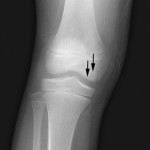Introduction
In the world of sports physiotherapy the assessment and diagnosis of knee pathology is a daily event. As we are all well aware, an accurate diagnosis is achieved only via a skilled subjective and objective examination. Thus, sports physiotherapists will regularly rely on the results of special orthopaedic or clinical tests to make a diagnosis. This is well covered ground on this site, as we regularly the discuss the diagnostic accuracy of clinical tests for common conditions, including:
However, there is always new research regarding the accuracy of existing techniques and the development of new ones. This leads to new research on the use of joint line fullness to assist in the diagnosis of meniscal tears. This article will discuss the technique and its potential clinical utility.
New Research Into Diagnosing Meniscal Pathology
Couture et al (2012) evaluated 100 consecutive patients (average age 46.1 years, 57 men) who were to undergo arthroscopy for suspected meniscus pathology. All patients underwent a physical examination which included documentation of:
- Joint Line Fullness
- Joint Line Tenderness
- McMurray’s Test
The authors intended to determine the sensitivity, specificity, and accuracy of the presence of joint line fullness (swelling) on physical examination in detecting the presence of meniscal cysts and/or meniscal tears compared with both MRI and arthroscopic findings.
The Joint Line Fullness Examination
The examination of joint line fullness was performed on a supine patient. To assess the lateral compartment the knee was flexed to 30-45º (relaxing the ITB) and at 70-90º for the medial compartment (relaxing the MCL). Similar to when palpating for joint line tenderness the examiner attempts to identify a palpable ‘fullness’, and a positive test occurs when there is a loss of normal joint line compression.
The Diagnostic Accuracy of Joint Line Fullness
The authors found some interesting results for the diagnostic accuracy of joint line fullness for detecting meniscal tears at arthroscopy:
- Sensitivity: 70%
- Specificity: 82%
- +ve LR: 3.9
- -ve LR: 0.375
- Sensitivity: 73%
- Specificity: 73%
- +ve LR: 2.7
- -ve LR: 0.37
If you compare these findings to those listed here (Hegedus et al., 2007), which compares the diagnostic accuracy of Joint Line Tenderness, McMurray’s, Apley’s Grind, Thessaly’s and MRI, you will see that this test may be quite useful for the diagnosis of potential medial meniscus tears. However, there are of course limitations to this research.
Limitations of this Research
As is always the case there are some limitations of this research. These include:
- The study population does not accurately reflect what we see in our clinical practice.
- Acute cases were not used, and the authors suggest that joint line fullness not be used as an indicator of meniscal pathology in this instance.
- The patient population were all to undergo arthroscopy for a suspected meniscal tear. This affects the generalisability of these stats to other populations
- The reliability, both inter-rater and intra-rater, of this ‘test’ has not been established
Clinical Implications
- The ‘Joint Line Fullness’ test may be useful for diagnosis of meniscal pathology in this population
- The test requires validation in other populations
- Your diagnostic accuracy will be improved when you use a battery of the meniscal tests
- This test may be considered in the painful knee, when movement is very difficult.
What Are Your Thoughts?
What are your thoughts on the use of this test? Is this an assessment technique that you regularly use in your own clinical practice, and if so, do you find it helpful? I would love you to let me know! Help us all out and leave a comment below, or hit me up on Facebook or Twitter. Are you a physiotherapist or physical therapist looking to promote your own clinic, check this out.
References
Couture JF, Al-Juhani W, Forsythe ME, Lenczner E, Marien R, Burman M. Joint line fullness and meniscal pathology. Sports Health: A Multidisciplinary Approach 2012;4(1):47
Hegedus EJ, Cook C, Hasselblad V, Goode A, McCrory DC. (2007) Physical Examination Tests for Assessing a Torn Meniscus in the Knee: A Systematic Review With Meta-analysis. Journal of Orthopaedic & Sports Physical Therapy 37(9).
Photo Credit: Rikx
Related Posts
Comments











A detailed history will alert the examiner that meniscal and / or articular pathology is likely. My experience would suggest that a combination of meniscal tests including testing for joint-line fullness, McMurrays and joint line palpation is going to provide the physiotherapist with the best combination of examination techniques to make the best recommendation to the patient. Cheers